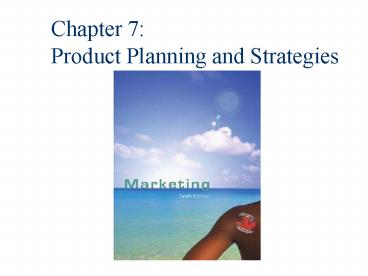Chapter 7: Product Planning and Strategies - PowerPoint PPT Presentation
1 / 20
Title:
Chapter 7: Product Planning and Strategies
Description:
The Product Life Cycle ... the life cycle must be considered in relation to ... successful life-cycle management requires predicting the shape of the curve and ... – PowerPoint PPT presentation
Number of Views:77
Avg rating:3.0/5.0
Title: Chapter 7: Product Planning and Strategies
1
Chapter 7Product Planning and Strategies
2
What is a Product?
- a set of tangible and intangible attributes,
including packaging, colour, price, quality, and
brand, plus service and reputation, that provides
a set of perceived benefits to consumers - it is more than physical products includes
services, places, persons, and ideas
3
Product Attributes
4
Consumer and Business Products
- depends on the intended target market how it is
used and by whom - Some products are sold only to consumers, others
are sold to organizations for use in the
business, for resale, or to provide services.
5
Classifying Consumer Products
- convenience low price, low risk, no need to shop
around, widely available - shopping want to compare quality and price, risk
and price are higher, available in selected
retail outlets - specialty strong brand preferences, risk is
high, prepared to seek out exclusive retail
outlets
6
Classifying Business Products
- raw materials unprocessed, become part of other
manufactured products - manufactured parts and materials processed
products that become part of other products - installations major buildings and equipment
- accessory equipment used in operations, include
computers, desks, tools - operating supplies low value, used by most
firms, convenience products for businesses
7
Deciding on the Product Mix
- the product mix is a collection of product lines
it has both breadth and depth - product line is a group of related products
- breadth is the number of product lines within the
mix - depth is the variety of sizes, models, or items
within each product line
8
Product Mix Breadth and Depth
9
Product Positioning
- Product position refers to the image that it
projects in the minds of consumers - a product may be positioned
- in relation to a competitor by drawing
comparisons - in relation to a product class or attribute by
stressing certain characteristics - to appeal to a specific target market
- on price, quality or value.
10
Expanding the Product Mix
- expansion is accomplished by increasing the depth
of lines or by adding lines - increasingly, this involves line extensions
- related products under the same brand
- unrelated products under the same brand
- or unrelated products under a different brand
- or related products under a different brand
11
Other Product-Mix Strategies
- trading-up adding a higher-priced product to
reach a broader market - trading-down adding a lower-priced product to a
line to attract people who can not afford the
higher-priced original - occasionally, a product will be altered to
improve it or to allow for its repositioning - new products or variations on current ones
12
Adoption-Diffusion Process
- different new products are adopted by consumers
at different rates - the individual consumer goes through certain
stages before adopting a new product
13
Stages in the Adoption Process
- awareness
- interest
- evaluation
- trial
- adoption
- confirmation
14
The Product Life Cycle
- applies to product categories, not to brands
(related to diffusion of innovation concept) - a product is normally perceived to pass through
four stages over its life cycle introduction,
growth, maturity, and decline - different products will have differently-shaped
life cycle curves will diffuse at different
rates - each stage requires different marketing
strategies
15
Typical Life Cycle of a Product Category
16
Characteristics of the Stages
- introductory stage developing the market,
creating awareness, reaching the innovators - growth stage competition begins, sales grow
quickly, profits peak, market penetration - maturity stage competition is intense, sales
slow down, differentiated product offerings,
customers are brand loyal, few new entrants - decline stage customers move to other options,
competitors leave, profits are low, consider exit
17
Characteristics of Life Cycles
- length of the life cycle will vary
- some products do not make it through all four
stages they may fail in introduction - the life cycle must be considered in relation to
a market stage may vary across segments
18
Product Life Cycle Variations
19
Managing the Life Cycle
- successful life-cycle management requires
predicting the shape of the curve and then
successfully adapting strategies at each stage - when to consider entering the market
- how to manage to capitalize on growth
- it is possible to develop strategies that will
extend the maturity stage modify the product,
devise new uses, or design new appeals - greatest challenge comes at the decline stage
20
For next class...
- Read Chpt. 8































